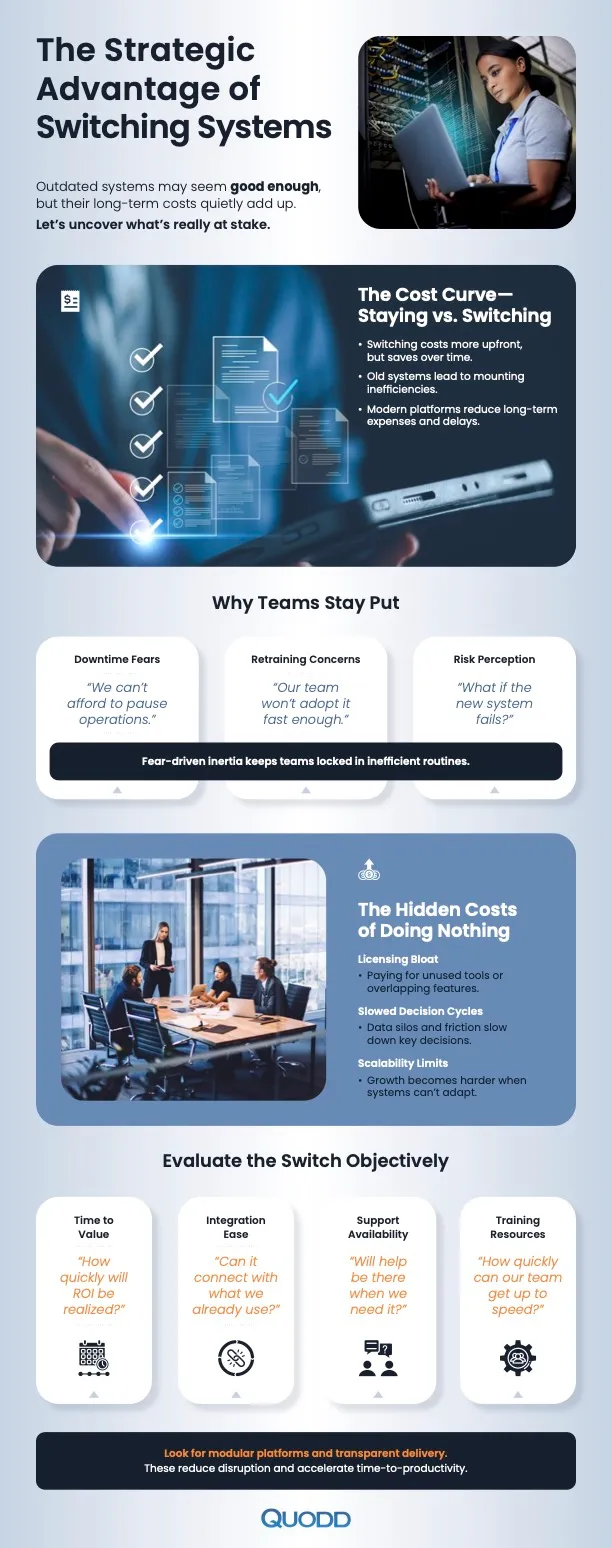
Editorial Disclaimer
This content is published for general information and editorial purposes only. It does not constitute financial, investment, or legal advice, nor should it be relied upon as such. Any mention of companies, platforms, or services does not imply endorsement or recommendation. We are not affiliated with, nor do we accept responsibility for, any third-party entities referenced. Financial markets and company circumstances can change rapidly. Readers should perform their own independent research and seek professional advice before making any financial or investment decisions.
Many businesses delay system upgrades, believing that the cost, disruption, and learning curve outweigh the benefits. However, the unseen expenses tied to outdated systems can steadily erode profitability. These hidden costs are rarely obvious on a balance sheet, but they manifest in inefficiency, lost opportunities, and increased operational risk. Over time, these inefficiencies can outpace the perceived savings of holding onto legacy tools. The longer these outdated systems remain in place, the more entrenched and costly their impact becomes.

Older systems often lack automation features that reduce repetitive work. This forces staff to spend hours on manual data entry, reconciliation, and reporting tasks that modern platforms could handle in minutes. Additionally, slow processing speeds and frequent downtime disrupt workflows, leading to missed deadlines and reduced output. The cumulative effect of small delays, repeated daily, can cost a company hundreds of productive hours each year. That loss impacts not only staff efficiency but also customer satisfaction, as service delivery times may lengthen. Over time, this inefficiency can erode a company’s competitive edge in its market.
Ageing systems may struggle with maintaining accurate and up-to-date records, which can lead to decision-making based on outdated or incomplete information. Poor data management also increases the likelihood of errors that can harm compliance, forecasting, and strategic planning. Security vulnerabilities are another significant risk. Without regular updates and patches, older systems become attractive targets for cyberattacks. If sensitive information, including security master data, is compromised, the financial and reputational damage can be severe. Preventative measures often cost less than the fallout from a breach.
Modern business operations rely on seamless communication between different tools and platforms. Legacy systems often cannot integrate with newer applications, creating isolated data silos. This lack of connectivity prevents teams from working with real-time, unified information and limits the ability to adopt emerging technologies. In turn, organisations miss opportunities to streamline processes, deliver better customer experiences, and compete more effectively. Over time, competitors using more adaptable systems may gain a clear market advantage.
While avoiding an upgrade may seem like a cost-saving measure, the ongoing expenses of maintaining outdated systems can be significant. Frequent repairs, custom patches, and the need for specialised technical support can quickly add up. These maintenance costs, combined with lost productivity and limited functionality, often outweigh the price of implementing a new system. Furthermore, as the gap between old and new technology widens, the eventual switch becomes more expensive and disruptive. This delay can also lead to compatibility issues with modern software and integrations, further hindering growth and efficiency.
Delaying a system upgrade is not a neutral choice; it is an investment in inefficiency and risk. Businesses that act proactively to replace outdated systems position themselves for greater efficiency, improved data security, and long-term competitiveness. The longer a company waits, the more these hidden costs accumulate, quietly undermining growth potential and operational stability. To learn more, look over the infographic below.

Many businesses put off system upgrades because they worry about the immediate costs, the disruption it might cause, and the time it takes for staff to learn new tools. They often believe these short-term challenges outweigh the long-term benefits.
The main hidden costs include reduced staff productivity due to manual tasks, poor data quality leading to bad decisions, significant security vulnerabilities, and the inability to integrate with modern tools. These issues can quietly erode a company's profitability.
Outdated systems often struggle to keep records accurate and current, which means decisions might be based on incomplete information. They also lack the latest security updates, making them much more vulnerable to cyberattacks and potential data breaches.
Absolutely. When systems cannot integrate with newer applications or adopt emerging technologies, a company misses chances to streamline operations and improve customer experiences. Competitors using more adaptable systems can then gain a significant market advantage.
Yes, in the long run, delaying an upgrade usually proves more expensive. The ongoing costs of maintaining old systems, frequent repairs, and the cumulative loss of productivity often exceed the price of implementing a new system. The eventual switch also becomes more costly and disruptive.
Many businesses delay system upgrades, believing that the cost, disruption, and learning curve outweigh the benefits. However, the unseen expenses tied to outdated systems can steadily erode profitability. These hidden costs are rarely obvious on a balance sheet, but they manifest in inefficiency, lost opportunities, and increased operational risk. Over time, these inefficiencies can outpace the perceived savings of holding onto legacy tools. The longer these outdated systems remain in place, the more entrenched and costly their impact becomes.